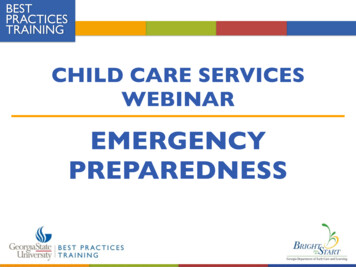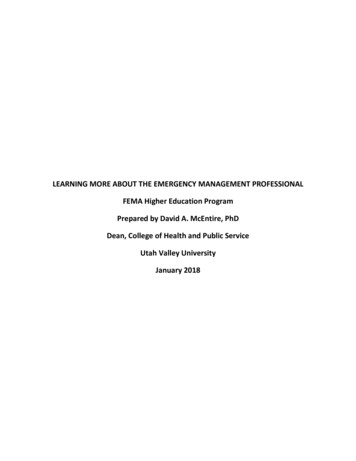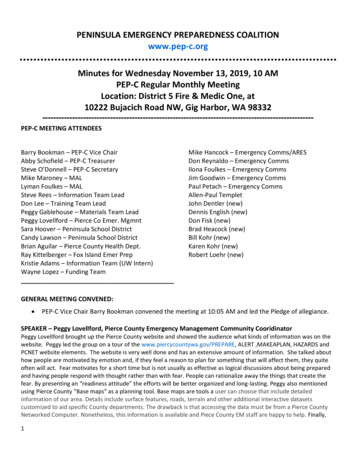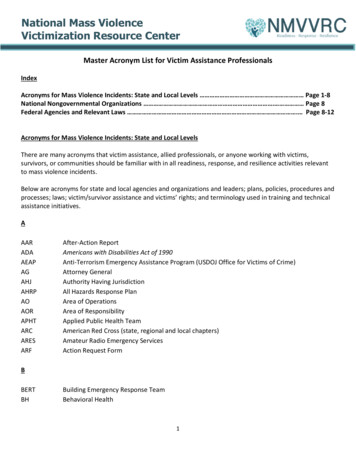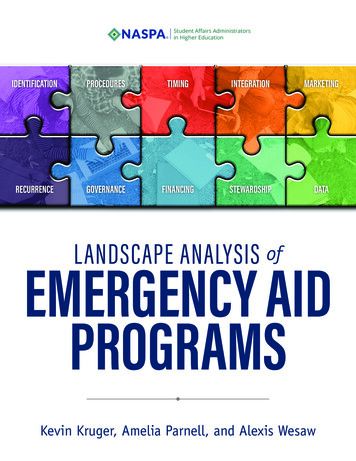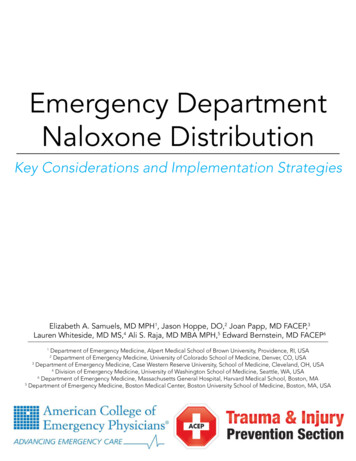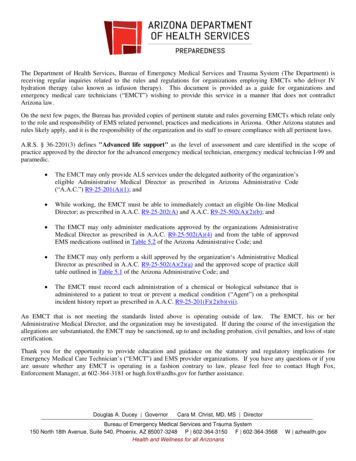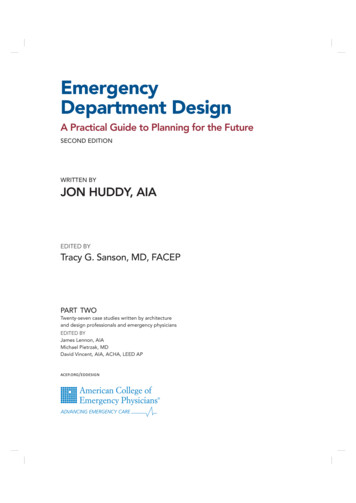
Transcription
EmergencyDepartment DesignA Practical Guide to Planning for the FutureSECOND EDITIONWRITTEN BYJON HUDDY, AIAEDITED BYTracy G. Sanson, MD, FACEPPART TWOTwenty-seven case studies written by architectureand design professionals and emergency physiciansEDITED BYJames Lennon, AIAMichael Pietrzak, MDDavid Vincent, AIA, ACHA, LEED AP Ö͘ÊÙ ͬ Ý Ä
FIRST PRINTING APRIL 2016ISBN 978-0-9889973-5-6Publisher’s NoticeThe American College of Emergency Physicians (ACEP) makes every effort to ensure thatcontributors to its publications are knowledgeable subject matter experts. Readers arenevertheless advised that the statements and opinions expressed in this publication are providedas the contributors’ recommendations at the time of publication and should not be construedas official College policy. ACEP recognizes the complexity of emergency medicine and makesno representation that this publication serves as an authoritative resource for the prevention,diagnosis, treatment, or intervention for any medical condition, nor should it be the basis forthe definition of or standard of care that should be practiced by all health care providers at anyparticular time or place. Drugs are generally referred to by generic names. In some instances,brand names might be added for easier recognition.To the fullest extent permitted by law, and without limitation, ACEP expressly disclaims all liabilityfor errors or omissions contained within this publication, and for damages of any kind or nature,arising out of use, reference to, reliance on, or performance of such information.Copyright 2016, American College of Emergency Physicians, Dallas, Texas. All rights reserved.Except as permitted under the US Copyright Act of 1976, no part of this publication may bereproduced, stored, or transmitted in any form or by any means, electronic or mechanical,including storage and retrieval systems, without permission in writing from the publisher. Printedin the USA.ACEP BOOKSTOREPO Box 619911, Dallas, TX 75261-9911800-798-1822, 972-550-0911bookstore.acep.org acep.org/eddesignAMERICAN COLLEGE OF EMERGENCY PHYSICIANSJessica Hamilton, Assistant EditorMarta Foster, Senior EditorRobert Heard, MBA, CAE, Associate Executive DirectorCOVER DESIGN James Normark, Irving, TexasINTERIOR DESIGN AND PRODUCTION Susan McReynolds, Carrollton, TexasPROOFREADING Wendell Anderson, NorthStar Writing & Editing, Eugene, OregonINDEXING Sharon Hughes, Hughes Analytics, Goreville, IllinoisPRINTING Modern Litho, Jefferson City, Missouriii
Table of ContentsAbout the Author . . . . . . . . . . . . . . . . . . . . . . . . . . . . . . . . . . . . . . . . . . . . . . . . vIn Appreciation . . . . . . . . . . . . . . . . . . . . . . . . . . . . . . . . . . . . . . . . . . . . . . . . . viiAbout the Editor . . . . . . . . . . . . . . . . . . . . . . . . . . . . . . . . . . . . . . . . . . . . . . . . ixContributors . . . . . . . . . . . . . . . . . . . . . . . . . . . . . . . . . . . . . . . . . . . . . . . . . . . xiForeword. . . . . . . . . . . . . . . . . . . . . . . . . . . . . . . . . . . . . . . . . . . . . . . . . . . xvChapter 1An Architect’s Retrospective . . . . . . . . . . . . . . . . . . . . . . . . . . 1Chapter 2Preparing to Lead and Internal Team-Building . . . . . . . . . . . 19Chapter 3Project Delivery Options and Selecting Your Consultants,Designers, and Builders . . . . . . . . . . . . . . . . . . . . . . . . . . . . . 35Chapter 4Project Justification and Needs Assessment . . . . . . . . . . . . . 61Chapter 5Scope Definition . . . . . . . . . . . . . . . . . . . . . . . . . . . . . . . . . . 99Chapter 6The Design Puzzle: Pieces and Parts . . . . . . . . . . . . . . . . . . 133Chapter 7Design Components, Configurations, andConsiderations . . . . . . . . . . . . . . . . . . . . . . . . . . . . . . . . . . . 193Chapter 8Insights for Specialty Emergency Departments . . . . . . . . . . 237Chapter 9Wrap-Up – Imagine an Emergency Care Environmentin the Distant Future . . . . . . . . . . . . . . . . . . . . . . . . . . . . . . 275PART TWOCase Studies . . . . . . . . . . . . . . . . . . . . . . . . . . . . . . . . . . . . 285Case Study 1Anne Arundel Medical Center, Emergency Department . . . 289Case Study 2Bayhealth Medical Center, Kent General PavilionEmergency Department . . . . . . . . . . . . . . . . . . . . . . . . . . . . 293Case Study 3CGH Medical Center, Emergency Department . . . . . . . . . . 299Case Study 4Charleston Area Medical Center, Memorial HospitalEmergency Department . . . . . . . . . . . . . . . . . . . . . . . . . . . . 305Case Study 5Concord Hospital, Emergency Department. . . . . . . . . . . . . 309Case Study 6CoxHealth South, Emergency Department . . . . . . . . . . . . . 315Case Study 7Le Bonheur Children’s Hospital, Emergency Department . . . 321Case Study 8Lenox Health Greenwich Village, FreestandingEmergency Department . . . . . . . . . . . . . . . . . . . . . . . . . . . . 327Case Study 9Massachusetts General Hospital,Emergency Department . . . . . . . . . . . . . . . . . . . . . . . . . . . . 333Case Study 10 Massachusetts General Hospital, Lunder BuildingEmergency Department . . . . . . . . . . . . . . . . . . . . . . . . . . . . 339iii
Case Study 11 MedStar Washington Hospital Center, Project ER One . . . . 343Case Study 12 Memorial Hermann Northwest Hospital,Emergency Department . . . . . . . . . . . . . . . . . . . . . . . . . . . . 347Case Study 13 Methodist Dallas Medical Center,Emergency Department . . . . . . . . . . . . . . . . . . . . . . . . . . . . 349Case Study 14 Methodist University Hospital, Emergency Department . . . 355Case Study 15 OhioHealth Westerville, FreestandingEmergency Department . . . . . . . . . . . . . . . . . . . . . . . . . . . . 361Case Study 16 Penn State Hershey Medical Center,Emergency Department . . . . . . . . . . . . . . . . . . . . . . . . . . . . 365Case Study 17 Saint Francis Hospital, Trauma Emergency Center . . . . . . . 371Case Study 18 Southwest General Health Center,Emergency Department . . . . . . . . . . . . . . . . . . . . . . . . . . . . 377Case Study 19 Stafford Hospital, Mary Washington Healthcare,Emergency Department . . . . . . . . . . . . . . . . . . . . . . . . . . . . 383Case Study 20 Tampa General Hospital, Emergency andTrauma Center . . . . . . . . . . . . . . . . . . . . . . . . . . . . . . . . . . . 387Case Study 21 United Hospital, Peter J. King Emergency Care Center . . . 391Case Study 22 University Hospital of Bern, Intensive Care,Emergency Center, Operational Center . . . . . . . . . . . . . . . 395Case Study 23 University of Colorado, Emergency Department . . . . . . . . . 397Case Study 24 University of Colorado Health, Greeley Emergencyand Surgery Center . . . . . . . . . . . . . . . . . . . . . . . . . . . . . . . 401Case Study 25 University of Michigan Hospital and Health Centers,Emergency Critical Care Center. . . . . . . . . . . . . . . . . . . . . . 405Case Study 26 University of Pittsburgh Medical Center,Mercy Hospital Emergency Department . . . . . . . . . . . . . . . 411Case Study 27 University of Texas MD Anderson Cancer Center,Emergency Center . . . . . . . . . . . . . . . . . . . . . . . . . . . . . . . . 417Indexiv. . . . . . . . . . . . . . . . . . . . . . . . . . . . . . . . . . . . . . . . . . . . . . . 421Emergency Department Design
About the AuthorJon Huddy, AIA, as of the publishing of this book, has participated in the analysis,planning, and design of more than 325 emergency departments and counting. Hisemergency department design experience includes projects across the United States,Canada, South America, and Europe. While an architect by training, his emergencydepartment design experience includes a deep understanding of strategic planning,technology integration and how the physical environment can be shaped to supportlean operations; allow for efficient staffing and provider coverage; keep the staff andpatients safe; and help deliver successful outcomes that result in elevated patient andstaff satisfaction scores. His designs have accommodated emergency departmentsas small as 6,000 annual visits in rural areas and complex medical center emergencydepartments as large as 200,000 visits. One of his greatest attributes is the ability tobring alternative operational and physical design solutions to his clients by drawing onhis international emergency department design experience.As president of Huddy HealthCare Solutions, LLC, a firm focused on the specialty of emergencydepartment consulting and design, he personally leads each emergency department engagement,whether it be for emergency department strategic planning, operational assessment, masterplanning, and/or architectural design services. Mr. Huddy has been designing health care facilitiessince earning a Master of Architecture degree from the Clemson University Architecture forHealth Studio in the mid-1980s. He also completed the American Institute of Architects/AmericanHospital Association Graduate Fellowship in Health Facility Design. Since the early 1990s, Mr.Huddy has focused on the specialty of emergency department consulting and design and hasteamed with hundreds of hospitals, physician groups, architects, and builders to deliver successfulemergency department design solutions.Mr. Huddy is a member of the American Institute of Architects and is licensed by the NationalCouncil of Architectural Registration Boards. He has written several articles and deliverednumerous international presentations and educational sessions on a wide range of topics,including “ED Vision 2030,” “Designing More (ED) with Less (Capital),” and “Designing Safe andSecure Emergency Departments.” Many of the items and issues from these presentations arepresented in this book. His audiences have included the: American College of Emergency Physicians (ACEP, US)American Organization of Nurse Executives (AONE, US)American Society for Healthcare Engineering (ASHE, US)Center for Health Design (CHD, US)Emergency Nurses Association (ENA, US)European Society of Emergency Nurses (EuSEN)Health Estates & Facilities Management Association (HefmA, UK)Institute of Healthcare Engineering and Estate Management (IHEEM, UK)National Ergonomics Conference (US)Scottish Health Conference (UK)Health and Care Infrastructure Research and Innovation Centre (HaCIRIC, UK)International Emergency Department Leadership Institute (IEDLI)“Huddy,” as he has been known since grade school, brings a passion for emergency departmentdesign, a commitment to including caregivers throughout the design process, and a humorous,energetic presentation style that has allowed him to develop close and lasting relationships withemergency department caregivers around the world. His unique insights, depth of experience,and impressive track record of successful emergency department design projects are the buildingblocks from which he has written this text.Huddy is very interested in hearing about your unique design solutions to the challenges youface in creating your emergency department of the future. He can be reached at 803-517-7522or j.huddy@huddyhealthcare.com.v
In AppreciationI would like to express my sincere appreciation to the following people for their support,encouragement, and guidance during the development of this book:To the American College of Emergency Physicians for inviting me to write the secondedition of this book.To ACEP’s senior editor, Marta Foster, for actually signing up to work with me again!She has taken the “wandering text” of this architect and fine-tuned it into an easy-toread, easy-to-use reference tool.Special thanks to my friends Jessica Baker, Jim Jepson, Kathy Clarke, David White,Freda Lyon, Mary Jagim, Susan Sheehy, Rich Simone, and Liz Jones for their uniqueinsights that I have incorporated into this book.Special thanks to my international friends who have consistently given me insights tohealth care around the world: the Canadian health care system: Joanne McFaddenand Jerald Peters; insights to the UK’s National Health Service: Liz Smith and DuncanSissons; support during travel across UK and Europe: Melanie Grahame and NicolleCzternastek; and a tour of the UK pubs: Bob Taylor.To my father, Al, and to the memory of my mother, Barbara, for their eternal love andsupport.And finally, to my wife, Suzanne, and to my children: Tyler, Austin, and Marissa, for theirlove and support (and cutting sarcasm that seems to be a large part of Huddy heredity).— Jon Huddyvii
About the EditorTracy G. Sanson, MD, FACEP, is an emergency physician with more than 20 years ofexperience in emergency medicine education, emergency department management,and leadership. She was the director of the Division of Global Emergency MedicalSciences (GEMS) at the University of South Florida and is Co-Chief Editor of GEMSJournal of Emergencies, Trauma, and Shock.Dr. Sanson has served in several and varied leadership positions with the Society forAcademic Emergency Medicine (SAEM), the Council of Residency Directors (CORD),and the American College of Emergency Physicians (ACEP). She chairs the College’sEducational Meetings Subcommittee and is a member of the ACEP Speaker’s Bureauand the 911 network. She has been a member of the ACEP faculty for many years,including the ACEP Teaching Fellowship and the Emergency Department DirectorsAcademy. Dr. Sanson received the National Emergency Medicine Faculty TeachingAward in 2006.Tracy has held director positions with the US Air Force, the University of South Florida, andTeamHealth for the past 20 years. She completed her medical degree and residency training atthe University of Illinois at Chicago. She has served on TeamHealth’s Medical Advisory Board,Patient Safety Office Division, and as faculty in their leadership courses. Dr. Sanson heads herown consulting firm, specializing in emergency department team and satisfaction assessments,leadership training, personal development/coaching, and branding. She has consulted andlectured nationally and internationally on administrative and management issues, leadership,professionalism, communication, patient safety, brand development, personal development,women’s issues, and emergency medical clinical topics for a wide range of health careorganizations.ix
ContributorsThe author gratefully acknowledges the contributors to this new edition.Brian Aldred, MDJessica BakerKathy Clarke, RN, BSN, CENMarysol Imler, RNJim Jepson, AIALiz Jones, AIAAbel LongoriaTed Mallin, AIAJoanne McFadden, BID, PIDIM, IDA, IDC, LEED APCarlos Moreno, AIAJerald Peters, Architect, AAA, AIBC, MAA, SAA, OAA, FRAIC, LEED APRich SimoneSusan Sheehy, PhD, RN, FAEN, FAANDuncan Sissons, BSc, MRICS, Dip Proj Man, MAPM, MIODLiz Smith, RGNAhmad Wazzan, MDDavid White, MBAJim ZazaThe American College of Emergency Physicians gratefully acknowledges thearchitectural firms and hospitals that contributed to the case studies section.James Lennon, AIAMichael Pietrzak, MDDavid Vincent, AIA, ACHA, LEED APHKS Inc.EditorsAnne Arundel Medical Center, EmergencyDepartmentAnnapolis, MarylandThe MS2 GroupProvidence, Rhode IslandEmilio S. Belaval, MD, FAAEM, PresidentJoseph Twanmoh, MD, MBA, FACEP,Vice PresidentBayhealth Medical Center, Kent GeneralPavilion Emergency DepartmentDover, DelawareEwingColePhiladelphia, PennsylvaniaMary Frazier, AIA, LEED AP, PrincipalCGH Medical Center, Emergency DepartmentSterling, IllinoisCannonDesignChicago, IllinoisManuel Hernandez, MD, MBA, FACEP,Principal, CannonDesignCynthia Zander, Chief Operating Officer,CGH Medical CenterCharleston Area Medical Center, MemorialHospital Emergency DepartmentCharleston, West VirginiaBSA LifeStructuresIndianapolis, IndianaDon Altemeyer, AIA, ACHAJeff Cowsert, NCARBConcord Hospital, Emergency DepartmentConcord, New HampshireShepley BulfinchBoston, MassachusettsDavid Meek, Associate AIA, LEED APCoxHealth South, Emergency DepartmentSpringfield, MissouriThe Beck GroupDallas, TexasSean Wilson, Director of Healthcare DesignLe Bonheur Children’s Hospital,Emergency DepartmentMemphis, TennesseeFKP Architects, Inc.Dallas, TexasGary S. Owens, FAIA, ACHA, LEED APxi
Lenox Health Greenwich Village,Freestanding Emergency DepartmentNew York, New YorkPerkins EastmanNew York, New YorkJeffrey Brand, AIA, Principal, ExecutiveDirector, and National Healthcare PracticeArea LeaderMassachusetts General Hospital,Emergency DepartmentBoston, MassachusettsNBBJBoston, MassachusettsBenjamin A. White, MD, Director of ClinicalOperationsMichael NollMassachusetts General Hospital, LunderBuilding Emergency DepartmentBoston, MassachusettsNBBJNew York, New YorkJoan Saba, Global Healthcare Practice Leader/PartnerMedStar Washington Hospital Center,Project ER OneWashington, DCHKS Inc.Dallas, TexasMichael P. Pietrzak, MD, Healthcare StrategicInitiatives, HKS Inc., and Project ER OneManaging DirectorJames Lennon, AIA, HKS Inc.David Vincent, AIA, ACHA, LEED AP, Principaland Senior Vice President, HKS Inc.Mark Smith, MD, Chief Innovation Officer,MedStar HealthMemorial Hermann Northwest Hospital,Emergency DepartmentHouston, TexasPhiloWilke PartnershipHouston, TexasJennifer Young, AIA, Associate PartnerMethodist Dallas Medical Center, EmergencyDepartmentDallas, TexasPerkins WillDallas, TexasDavid Collins, AIA, LEED AP, RegionalHealthcare Practice Leader/Design PrincipalCary Garner, AIA, LEED AP, Managing PrincipalxiiMethodist University Hospital, EmergencyDepartmentMemphis, TennesseeFrank Zilm & Associates, Inc.Kansas City, MissouriFrank Zilm, DArch, FAIA, FACHA, PresidentJon R. Summers, Principal, brg3sOhioHealth Westerville, FreestandingEmergency DepartmentWesterville, OhioDesignGroupColumbus, OhioElliot Bonnie, Principal, Healthcare DesignerPenn State Hershey Medical Center,Emergency DepartmentHershey, PennsylvaniaEwingColePhiladelphia, PennsylvaniaThaddeus J. Przybylowski, Jr., RA, LEED AP,PrincipalSaint Francis Hospital, Trauma EmergencyCenterTulsa, OklahomaPageDallas, TexasJames Augustine, MD, FACEP, Director ofClinical Operations, Emergency MedicinePhysiciansJoshua Theodore, ACHE, EDAC, PrincipalHealth Industries Design, PageSouthwest General Health Center,Emergency DepartmentMiddleburg Heights, OhioCannonDesignChicago, IllinoisScott Thomas, Senior Vice President,CannonDesignTerri Rini Barber, Vice President of SupportServices and Chief Information Officer,Southwest General Health CenterStafford Hospital, Mary Washington Healthcare,Emergency DepartmentStafford, VirginiaX32 HealthcareFredericksburg, VirginiaJody Crane, MD, MBA, PrincipalKelly McDonough, DPN, RN,Administrative Director, Nursing Practiceand Nursing Operations
Tampa General Hospital, Emergencyand Trauma CenterTampa, FloridaGresham, Smith and PartnersNashville, TennesseeRobert A. Berry, AIA, NCARB, EDACUniversity of Pittsburgh Medical Center,Mercy Hospital Emergency DepartmentPittsburgh, PennsylvaniaGBBN Architects, Inc.Cincinnati, OhioTodd Dunaway, AIA, EDAC, PrincipalUnited Hospital, Peter J. King EmergencyCare CenterSaint Paul, MinnesotaMichaud Cooley EricksonMinneapolis, MinnesotaJeff Clark, LEED AP, PrincipalUniversity of Texas MD Anderson CancerCenter, Emergency CenterHouston, TexasPhiloWilke PartnershipHouston, TexasCathryn Horan, PartnerUniversity Hospital of Bern, Intensive Care,Emergency Center, Operational CenterBern, SwitzerlandItten Brechbühl Inc., and Lead ConsultantsInc.Bern, SwitzerlandHugo Erni, Lead Consultants Inc.Jost Kutter, Itten Brechbühl Inc.University of Colorado,Emergency DepartmentAurora, ColoradoHDR, Inc.Omaha, NebraskaJennifer L. Wiler, MD, MBA, FACEPJ. Stephen Bohan, MS, MD, FACEPRichard Zane, MDUniversity of Colorado Health,Greeley Emergency and Surgery CenterGreeley, ColoradoH L ArchitectureDenver, ColoradoSteve Carr, Principal-In-ChargeBarrett Koczkur, Project ArchitectCherie Dice, Interior DesignUniversity of Michigan Hospital and HealthCenters, Emergency Critical Care CenterAnn Arbor, MichiganNiagara MuranoBirmingham, MichiganBenjamin Bassin, MD, FACEPJennifer Gegenheimer-Holmes, RN, BSN,MHSACemal Sozener, MD, MEng, FACEPxiii
Foreword“It is difficultto get the news from poemsyet men die miserably every dayfor lack of what is found there.”Physician and poet William Carlos Williams held deeply to the belief that poetry was not anenigmatic endeavor reserved for mystics and shamans, but that it could impart a true andcorporeal impact on those exposed to it. In both good design and good caregiving there ispoetry, there is empathy, there is a desire to best aid those who find themselves at our door.In few places is the importance of careful and conscientious design so evident as theunpredictable environment of an emergency department; a place in which meetings are direand contingency is one of the few constants, a place where every possibility is one that mustbe prepared for. This is a space where the unexpected lives, a doorway, a place where quickresponses will dictate how we are to emerge. In a space where infinite possibility and uncertaintyreign, careful architecture is of the utmost importance — because where there lives the possibilityof chaos, so too lives the sister possibility of comfort. It is our job to do everything we can to tipthe scale in comfort’s favor. That is the aim of this book.The history of the emergency medicine winds back past Clara Barton and Napoleon’s earlyambulance service, even further back toward the Knights Hospitaller, bringing relief to injuredpilgrims during the Crusades. We find ourselves here, thousands of years later, with the future ofour practice winding in new directions still.Even in the brief years since this book’s last publication, the needs of emergency departmentshave changed rapidly. As an example, the danger to health care providers in professional settingsescalates as violence moves off the streets and into the medical setting. Optimal patient care isachieved only when patients, visitors, and health care workers are protected against violent actsoccurring within the health care setting. A safe working environment is conducive to improved staffmorale and enhanced productivity and has been addressed in this edition. Managing the changingexpectations of emergency care can be one of the most stressful and challenging tasks we face.Working with these rapidly evolving expectations of the care we provide will require flexibility,durability, and an attitude of optimism. This requires adaptable environments. This publicationpresents the tools to appropriately and, at times, innovatively respond to the needs of both thepatient and staff. Case in point, this edition resisted the trend toward increasing patient evaluationspace at the expense of staff needs, instead recommending adequate break rooms and staff restrooms and even addressing the concerns for breastfeeding employees requiring a private spacein which to pump. This edition works to positively and creatively channel your time and energycommitment in developing a “Great place to heal and Great place to work” department.At the heart of this book is a question: what would an emergency department designed withefficiency, effectiveness, and care at the heart of it look like? This book is intended to fastentogether the worlds of all those involved in the design process, allowing each to navigate theother. In designing effective emergency departments, we are called to be both physician andarchitect, both scientist and poet. To achieve this, we must ask the right questions. This book is anexcellent place to begin.There is power in excellent caregiving as there is power in excellent design. When the two meet,that’s where poetry and comfort will live.—Tracy G. Sanson, MD, FACEPxv
CHAPTERAn Architect’s RetrospectiveAn Emergency Department ArchitectLooks Back: What a Long Journey!Wow, what a wild ride it’s been since I wrote and ACEP published the lastemergency department design book more than 14 years ago. At the timeof the last edition (referred herein as the 2002 edition), I had to date beeninvolved in approximately 60 emergency department design projects. Now, as I reflect back on how emergency department design has changed since the turn of thecentury, I have the opportunity to draw from experiences of being involved in morethan 325 emergency department design projects. This experience includes emergency departments of all sizes, shapes, and configurations and has taken me fromAlaska to Hawaii to Florida in the United States, across Canada, down to Colombia,South America, and over to the Netherlands, Scotland, and England. While everylocation has unique emergency department design goals, it’s amazing how muchthe challenges of each emergency department project are similar: having to shapeoperations and an environment to treat rising patient volumes and escalating acuities with less capital to spend on new facilities. Everyone in the world is focused ondeveloping high-performance facilities in less space with smaller project budgets.The variables shaping future emergency department designs are multiplyingexponentially as the complexities of health care continue to evolve. The designresponses for each client’s set of unique operational goals include innovativeresponses for flexibility, efficiency, surge capacity, safety, technology integration,patient satisfaction, and staff satisfaction. And all of these variables need to be metwithin dwindling project budgets due to a tight worldwide economy and unknownfuture with regard to (in the United States) health care reform. Back at the turn ofthe century, the chief concern for most emergency department clients was, “Howdo we get away from curtained cubicles to all private rooms?” A few years later, theemphasis on lean operations added the focus of, “How do we make everything andeveryone as efficient as possible?”1
At the publishing of this book, early evidence suggests similar results as to what wasrecently found in The Wall Street Journal, that “American emergency departments havebecome busier since the Affordable Care Act expanded insurance coverage despite thelaw’s goal of reducing unnecessary care in ‘ER.’”1 In Louisville, Kentucky, The CourierJournal reported that, nationally, nearly half of emergency physicians responding to arecent poll by the American College of Emergency Physicians said they’ve seen more visitssince January 1, 2014, and nearly nine in 10 expect the number of visits to rise in the next3 years.2So, in the United States, with rising acuities, continued integration of technology, andgrowing competition (from competitor hospitals, freestanding emergency departments,urgent care centers, and commercial store-based convenience care clinics), the future ofemergency care is headed for unforeseen horizons. Similar struggles are being felt withrising volumes in Canada and nearly all areas of Europe. And the design considerations toapply to your physical emergency department design to balance against the uncertain futureare nearly overwhelming. However, I worked hard to develop this book in a way that willhelp you to define the key variables unique to your facility and services and to set the keyarchitectural design drivers that will deliver success, no matter what country or regionyou’re serving. This book will also present multiple options for design responses based onlean operational patient flow, rising acuities, volume surges, safety concerns, upgrading thepatient experience, and the ability to treat the right patient in the right place by the rightperson.The 2002 edition of this book was beneficial for the many physician leaders, nursingleaders, health care organizational leaders, and design professionals as they ventured intothe process of redesigning, expanding, or relocating an emergency department for thefirst time. However, times have changed, and I know that developing a new edition forthis book meant reviewing the information in the last edition, identifying what may stillbe applicable in the future, jettisoning the now-irrelevant information, and developinga new set of strategic emergency department design drivers based on the complexitiesof today’s health care environment, including an eye to the future. I believe this editionwill be a valuable asset to any emergency physician, nursing director, facilities director,administrator, architect, or contractor who is facing the specter of shaping an emergencydepartment that will need to function for the next 15 to 20 years.Whom This Book Can HelpThis book is intended to help two types of professionals facing emergency departmentdesign projects:x The first-timer. You’re facing an emergency department project for the first time,and you need to understand the basics of initial planning methods, architecturaldesign processes, various design concepts, alternative construction deliverymethods, and the basic building blocks for sizing and shaping a successfulemergency department design.x The grizzled veteran. You’re headed into another emergency department designproject, and you might have read the last book, and now you want to explore new,updated design delivery methods, design concepts, and features to support futurelean operations.Please note that, throughout this book, I use the terms new or future, as in “yournew emergency department” or “your future emergency department.” These referencesare for any emergency department project—whether it be a completely new emergency2Emergency Department Design
department, large (or small) renovation, or expansion of your current department. Theterms new and future referred to within this text apply to any project you might beconsidering, no matter what size, scale, or cost.Also, when I refer to the design team, I mean all participants: physicians, nurses, staff,your facilities department, ancillary department representatives, your architect, and maybeeven your contractor (builder). Please don’t relate the term design team only to the outsideprofessional architectural and engineering designers with whom you are working. You’llsee throughout this book th
Jon Huddy, AIA, as of the publishing of this book, has participated in the analysis, planning, and design of more than 325 emergency departments and counting. His emergency department design experience includes projects across the United States, Canada, South America, and Europe. While an architect by training, his emergency


